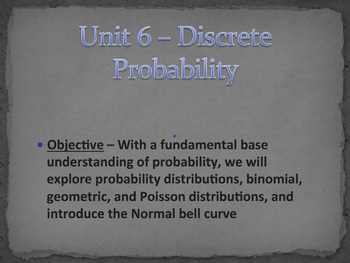Statistics Unit 6 Bundle - Discrete Probability (12 days)
- Zip
Description
This is a unit plan bundle for a Statistics class. The plans include common core math standards, time frame, activities, enduring understandings, essential questions, and resources used. It is designed to last 12 days, depending on pacing. The plans include:
39-slide presentation, with annotated guide for reference
3 Worksheets
"Do Now" Entrance problems
2 quizzes
Spreadsheet Activity - Binomial, Geometric, Poisson Disributions
Review slides (for student-group communicators)
Unit test (with review packet)
Pacing Guide with administrative unit plan
All with answer keys included
*The topics covered are discrete random variables, mean and standard deviation of a probability distribution, Binomial experiments and the binomial theorem, Geometric distributions, Poisson Distributions, mean and standard deviation of binomial, geometric, and poisson distributions. The documents are Word based, Powerpoint based, Excel Based, pdfs included, and completely editable. Enjoy!
**If you find this product useful, consider buying the bundle "A Mountain of Statistics Curriculum" for the entire class**
***Please read the "readme" text file and End User License Agreement contained in the Product. Thank you for respecting my work***





